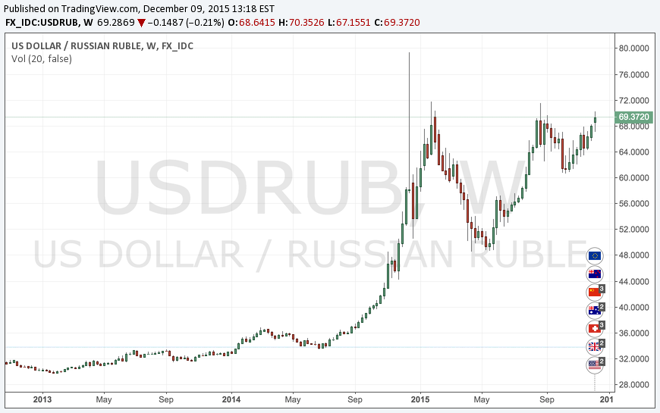Advertisement
Advertisement
USD/RUB Analysis and Predictions for 2016
Updated: Aug 15, 2016, 14:03 GMT+00:00
Exactly one year ago the Russian Ruble was one of the hottest topics amongst the trading community. While traders were looking to go short on the USD/RUB,
Exactly one year ago the Russian Ruble was one of the hottest topics amongst the trading community. While traders were looking to go short on the USD/RUB, brokers were increasing the swap values and limiting the leverage on the currency pairs that contained the ruble.
No wonder then, three weeks before the end of the year Russian Ruble nearly 80 rubles per US dollar, while the rate was fluctuating between 30 and 36 rubles per dollar for years. The reasons for such fluctuations are many; events in the Eastern part of Ukraine; the annexation of Crimea; trade embargoes; and more.
Impact of Oil Prices
Forex trading is certainly important in the world of trading, yet there are also commodities. Russia is the second largest producer of oil and 3rd largest net importer of this commodity. As a rule, many traders try to correlate the USD/RUB rate with the price of oil. Let’s take a look at the chart below.
We can, of course, spot a strong negative correlation between USD/RUB and WTI prices. The correlation is negative, meaning the lower the price per barrel gets, the more rubles one has to pay per dollar. However, it is also possible to notice that the correlation is slightly delayed. While in September 2014 the shift in USD/RUB pricing had just begun, oil had already lost nearly 15% of its value. Another commodity which is not so heavily correlated, yet contributes quite a lot towards Russia’s well-being is natural gas, and its value has been dropping too.
Interventions
Unlike oil prices that are mostly impacted by the decisions of OPEC, USD/RUB prices can also be highly impacted by the interventions of the Russian government. This can be highlighted by the falling value of USD/RUB in the first quarter of 2015. While there has not been a major shift in oil prices, USD/RUB has moved from around 70 rubles per dollar to just 50.
Impact on foreign trades
It is obvious that when a country’s currency becomes cheaper, imported goods are purchased for higher costs, meanwhile it becomes more profitable to export. Currently Russia has a very strong trading profile as it exports much more than imports. Nevertheless, one of its historically key trading partners is Turkey and due to the recent events this relationship might be spoiled.
Predictions for 2016
When you are considering investing in Forex, the USD/RUB could seem a viable option as 2015 volatility has been quite high and this pair can actually deliver great results over a relatively short period of time. We predict the price of oil to actually drop further and the same happen to natural gas prices and this should trigger the price of the USD/RUB to drop to around 72 rubles per dollar. This is an important level to watch out for, however such a rate could also trigger another intervention. For this reason it is suggested to actually go short on USD/RUB once the price passes the level of 72 rubles per USD.
However, a wise investor would pay more attention to fundamental events as they are much more likely to contribute towards changes in the rate of ruble.
About the Author
FX Empire editorial team consists of professional analysts with a combined experience of over 45 years in the financial markets, spanning various fields including the equity, forex, commodities, futures and cryptocurrencies markets.
Latest news and analysis
Advertisement
